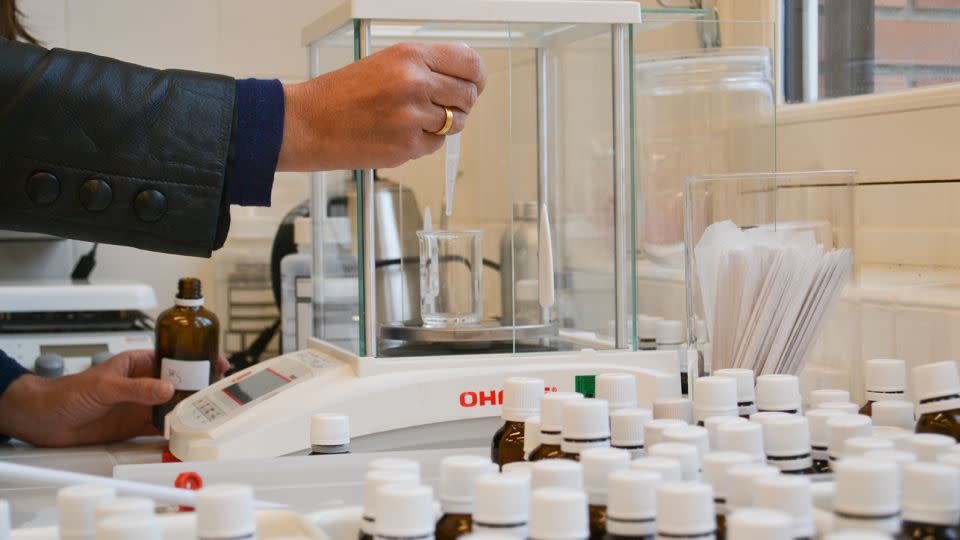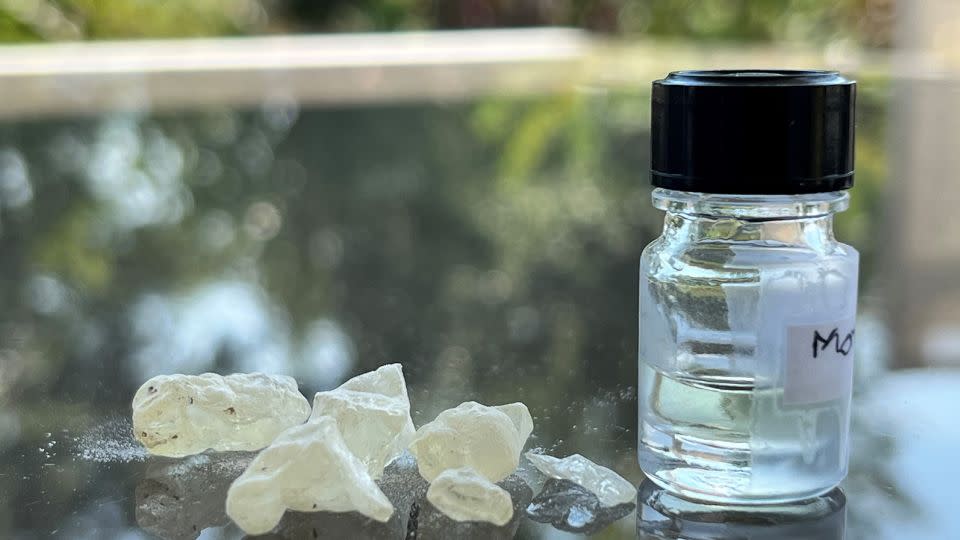A newly resurrected ancient smell may help reveal the life of a woman entombed with pharaohs
- Oops!Something went wrong.Please try again later.
Editor’s note: Sign up for CNN’s Wonder Theory science newsletter. Explore the universe with news on fascinating discoveries, scientific advancements and more.
Scientists have decoded an ancient aroma by identifying the ingredients used in Egyptian mummification balms — and resurrected the scent.
Those eager to sample this whiff of the past will be able to find what the researchers have dubbed “the scent of the eternity” during an upcoming exhibition at the Moesgaard Museum in Denmark.
Also called “the scent of eternal life,” the fragrance is based on the beeswax, plant oils and tree resins from distant lands the team found within balms used more than 3,500 years ago to preserve Senetnay, a noblewoman whose remains were placed within canopic jars and discovered in Egypt’s Valley of the Kings in 1900.
The discovery reveals insights into Senetnay’s social status as well as the methods used to preserve her remains and the significance of the balm ingredients. A study detailing the findings published Thursday in the journal Scientific Reports.
“The embalming ingredients found in Senetnay’s balms are among the most elaborate and diverse ever identified from this period, revealing the meticulous care and sophistication with which the balms were created,” said lead study author Barbara Huber, doctoral researcher at the Max Planck Institute of Geoanthropology in Germany.
“The presence of such a vast array of ingredients, including exotic substances like dammar or Pistacia tree resin, indicates that extremely rare and expensive materials were used for her embalming,” Huber added. “This points to Senetnay’s exceptional status in society.”
Uncovering Senetnay’s story
Little is known about Senetnay, but previous research has established that she lived around 1,450 BC and was the wet nurse of Pharaoh Amenhotep II, the long-awaited son and heir of Pharaoh Thutmose III. She took care of Amenhotep II and breastfed him as an infant.
Senetnay was bestowed with the title “Ornament of the King,” according to the historical record, and became a valued member of the Pharaoh’s entourage. After her death, Senetnay’s vital organs were embalmed and placed inside four canopic jars with lids in the shape of human heads.
The Egyptians carefully removed organs such as the lungs, liver, stomach and intestines during the mummification process to prevent bacterial growth and better preserve the body. Egyptians believed in preserving the body for the afterlife so a person’s soul would have a place to return, according to the study.

After the embalming process, the jars were placed inside a royal tomb in the Valley of the Kings, where Egyptologist Howard Carter found them in 1900. Senetnay’s body was not recovered. (Carter would later be credited with discovering Tutankhamun’s tomb in 1922.)
Senetnay’s inclusion in the Valley of the Kings, “a necropolis normally reserved for pharaohs and powerful nobles,” suggests “extraordinary privilege, and the high regard in which Senetnay was likely held by the Pharaoh,” according to the study.
“This work provides insight into the great efforts the Egyptians went to in their mortuary practices, and not just for Pharaohs, but other individuals in society,” said study coauthor Nicole Boivin, research group leader at the Max Planck Institute of Geoanthropology. “But it also makes clear that Senetnay was a significant person, with importance that surpasses the simple description of her as the wet nurse to the future Pharaoh Amenhotep II.”
Decoding the ingredients
The two jars that once contained Senetnary’s lungs and liver have been part of the Egyptian collection at the Museum August Kestner in Hannover, Germany, since 1935. They survived destruction during World War II by being stored in a salt mine. The other two jars, which were not part of the study, are kept in collections elsewhere.
The contents are long gone, but researchers were able to scrape the inside of the jars to study the residues left behind by the balms as well as what had seeped into the porous limestone of the jars.
The exact recipes used in the mummification have long been debated because ancient Egyptian texts don’t name precise ingredients. The team began its research to identify the balm ingredients in 2021 using a variety of highly advanced analytical techniques. The balms differed slightly between the two jars, which means that different ingredients may have been used depending on which organ was being preserved.

The balms contained beeswax, plant oils, animal fats, the naturally occurring petroleum product bitumen and resins. Compounds such as coumarin and benzoic acid were also present. Coumarin, which has a vanilla-like scent, is found in pea plants and cinnamon. Benzoic acid occurs in resins and gums from trees and bushes.
In the jar used to store Senetnay’s lungs, researchers detected fragrant resins from larch trees and something that is either dammar from trees found in India and Southeast Asia, or resin from Pistacia trees that belong to the cashew family.
“The presence of certain ingredients indicates that the Egyptians had established far-reaching trade routes and networks. Notably, the presence of larch tree resin — which originates from the northern Mediterranean and central Europe — and potentially dammars, resin exclusive to Southeast Asian tropical forests, underscore the vast reach of Egyptian trade routes during the mid-2nd millennium BCE,” Huber said.
The researchers are still working to confirm whether dammar was one of the ingredients.
“If it is dammar, it’s come a shockingly long way, and this provides new insight into ancient trade networks,” Boivin said in an email. “Travel was exceedingly difficult, and significant expeditions by sea were still relatively rare. It’s unlikely that the Egyptians themselves went to these far-off lands, but rather that they were part of exchange networks that linked up to other networks. But these were the early phases of the globalised world we live in today.”
If dammar is confirmed as an ingredient, it would also suggest that Egyptians had access to the resin nearly a millennium earlier than expected, the study authors said. Dammar was recently identified as an embalming ingredient at Saqqara, dated to the first millennium BC.
The new findings suggest that the relatively complex balms used in Senetnay’s preservation may have been the beginning of a trend of more elaborate ones used later on.
Recreating the scent
After identifying the ingredients, the research team worked with French perfumer Carole Calvez and sensory museologist Sofia Collette Ehrich to recreate the actual scent of the balm.
The meticulous process took months and multiple iterations before they landed on a historically accurate and evocative aroma, Huber said.

“The first time I encountered the scent, it was a profound and almost surreal experience,” she said. “After spending so much time immersed in the research and analysis, to finally have this tangible, aromatic connection to the ancient world was moving. It was like holding a faint echo from the past.”
The research team wanted to offer museumgoers a more immersive experience into the ancient world by incorporating an olfactory element while also making it more accessible to visually impaired visitors, she said. “The scent of eternal life” will be part of an ancient Egyptian exhibit at the Danish museum that opens in October.
“Scent provides a unique, visceral connection to the past, invoking a kind of time-travel that is intimate and evocative,” Huber said. “By reintroducing this ancient aroma, we aim to bridge the gap between then and now, allowing visitors to truly ‘breathe in’ a fragment of antiquity.”
For more CNN news and newsletters create an account at CNN.com

